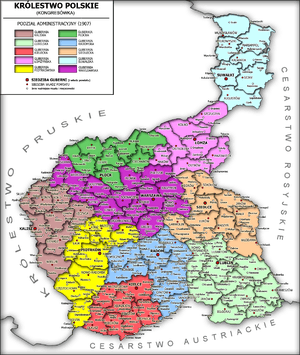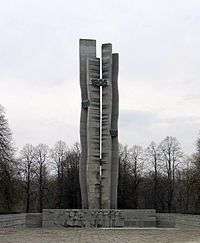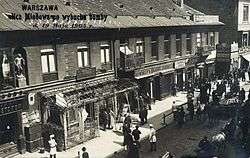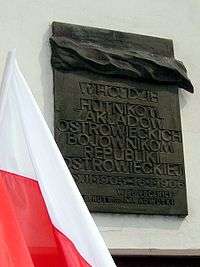Revolution in the Kingdom of Poland (1905–07)
| Revolution in the Kingdom of Poland 1905–1907 | |||||||
|---|---|---|---|---|---|---|---|
 Street demonstration in 1905 | |||||||
| |||||||
| Belligerents | |||||||
|
| ||||||
| Commanders and leaders | |||||||
|
| |||||||
The Revolution in the Kingdom of Poland (1905–1907) was a major part of the Russian Revolution of 1905 in Russian-partitioned Poland (see Congress Poland and Privislinsky Krai). One of the major events of that period was the insurrection in Łódź in June 1905. Throughout that period, many smaller manifestations, demonstrations and armed struggles between the peasants and workers on one side, and the government on the other, took place. The demands of the demonstrators included both the improvement of the workers' living conditions, as well as political freedoms, particularly related to increased autonomy for Poland. Particularly in 1905, Poland was at the verge of a new uprising, revolution, or a civil war.[1][2] Some Polish historians even consider the events of that period a fourth Polish uprising against the Russian Empire.[3]
Background

Worsening economic conditions (the recession of 1901-1903)[2] contributed to mounting political tensions in the Russian Empire, including Poland; the economy of the Kingdom of Poland was also being significantly hit by the aftershocks of the Russo-Japanese War; by late 1904 over 100,000 Polish workers had lost their jobs.[1] Conscriptions to the Russian army, and ongoing russification policies further aggravated the Polish population.[2] News and attitudes of the 1905 Russian revolution quickly spread from Saint Petersburg (where demonstrators were massacred on January 22) across the Russian Empire and into Russian-controlled Poland. This was capitalized on by factions in Russia and Poland that wanted more or less radical changes.[4]
In the meantime, two factions among the Polish political leaders clashed. The wing of the Polish Socialist Party (Polska Partia Socjalistyczna, PPS) that was loyal to Józef Piłsudski believed that Poles must show their determination to regain independence through active, violent protests against the Russians.[5][6] This view was not shared by Roman Dmowski's National Democratic Party (endecja)[6] nor by the PPS' own "Left" (or "Young") wing.[7] The National Democrats believed that the Poles should work together with the Russian authorities and increase their representation in the Duma (Russian parliament),[6] while the PPS Left wanted to work together with Russian revolutionaries to topple the Tsar and saw the creation of a socialist society as more important than Polish independence.[7]
The revolution
Łódź had in the 19th century become a major Polish industrial center, heavily urbanized and industrialized, and hence a stronghold of the socialist movement. Already before January 22, 1905 workers in Łódź were on strike, and on January 31 tsarist police reported that the strikers carried placards with slogans "Down with the autocracy! Down with the war!".[1] Similarly in Warsaw, former capital of Poland and another major industrial center, manifestations and demonstrations were common. There was a general strike in Warsaw on January 14; there were over 90 fatalities in Warsaw over the next few days[1][2] and on January 17 the Russian government declared that Warsaw was under the state of siege.[1]

On 28 January the PPS and the Social Democracy of the Kingdom of Poland and Lithuania called for a general strike; over 400,000 workers became involved in strikes all over Poland, a strike that lasted for four weeks.[2][4] This was only a prelude to an even larger series of strikes that rocked Poland over next year.[4] In the years 1905-1906 close to 7,000 strikes and other work stoppages occurred, involving 1,3 million Poles.[4] Protesters demanded both improved conditions for workers and more political freedom for the Poles.[1][2] By February, students at Polish universities had joined the demonstrations, protesting russification and demanding the right to study in Polish language.[1][2] They were joined by high school students and even some from the elementary schools.[1] While the Russian government gave in and agreed to some concessions towards the Polish nationalist movement (removing some restrictions on the use of Polish in the classrooms), many - particularly the workers - were still unsatisfied.[1][4] In some places in Poland, the school strikes lasted for close to three years.[4] Major demonstrations occurred on May 1 (Labour Day), and about 30 people were shot during a demonstration in Warsaw.[1][6] Later that month, for a time, public order disintegrated in Warsaw during a spontaneous campaign against the criminal elements as well as Russian collaborators.[4]

In mid-June 1905, Russian police opened fire on one of many workers' demonstrations in Łódź.[2][4][8] The resulting Łódź insurrection saw several days of fighting within the cities and over two thousands of casualties including over hundred of fatalities among the civilians.[2][4][8] Various protests and strikes occurred in major Polish cities under Russian control throughout the year[1] - but as Polish journalist Włodzimierz Kalicki wrote the Łódź insurrection was the most dramatic one.[8] The Russian government contributed to the chaos, by trying to incite some anti-Jewish pogroms.[4] Another notable occurrence was the establishment of the Zagłębie Republic (Republika Zagłębiowska), a Polish socialist statelet centered around the region of Zagłębie Dąbrowskie, that existed from October to November 1905.[2] A similar socialist state of Ostrowiec Republic (Republika Ostrowiecka) around the city of Ostrowiec Świętokrzyski existed from late December 1905 to mid-January 1906.[9]
Aftermath

While majority of the unrest occurred in 1905, until 1906-1907 worker unrest, demonstrations and occasional armed clashes continued to occur in Poland.[2] Strikes in Łódź continued until mid-1906, when only the large Russian military presence and mass layoffs of striking workers from the factories pacified the city.[4][8] The unrest in Poland forced the Russians to keep an army of 250,000-300,000 soldiers there - an army even larger than the one fighting Japanese in the east.[1]
Piłsudski's Combat Organization of the Polish Socialist Party, founded in 1904, and which contributed to escalation of some of the hostilities, became more active during the next few years, starting its campaign of assassinations and robberies mostly from 1906 onward, although they grew much weaker near the end of the decade.[2][4][10] Piłsudski's faction was temporarily weakened, and PPS split, although by 1909 Piłsudski's faction again regained prominence on the Polish underground political scene.[11] Piłsudski eventually succeeded in securing Polish independence, and became an important political figure in interwar Poland.
Another consequence was the evolution of Polish political parties and thought.[3] National consciousness had risen among the Polish peasants. Despite the failure of the most radical of conceptions, the Russian government conceded to some of the demands, both in the social and in the political science, counteracting the defeatist feelings among many Poles who were still reminiscent about the total defeat of the previous uprisings; in particular, russification was partially reversed in education in Poland.[3]
Revolution of 1905 in Polish paintings
 Witold Wojtkiewicz Manifestacja uliczna (Street demonstration)
Witold Wojtkiewicz Manifestacja uliczna (Street demonstration).jpg) Stanisław Masłowski Wiosna roku 1905 (Spring of year 1905). Cossack patrol escorting teenage insurrectionists.
Stanisław Masłowski Wiosna roku 1905 (Spring of year 1905). Cossack patrol escorting teenage insurrectionists. Władysław Skoczylas, Demonstracja uliczna w 1905 (Street demonstration in 1905)
Władysław Skoczylas, Demonstracja uliczna w 1905 (Street demonstration in 1905)
See also
References
- 1 2 3 4 5 6 7 8 9 10 11 12 Abraham Ascher, The Revolution of 1905: Russia in Disarray, Stanford University Press, 1994, ISBN 0-8047-2327-3, Google Print, p.157-158
- 1 2 3 4 5 6 7 8 9 10 11 12 (Polish) Rewolucja 1905-1907 w Królestwie Polskim, WIEM Encyklopedia, Retrieved on 9 October 2007
- 1 2 3 (Polish) REWOLUCJA 1905-07 NA ZIEMIACH POLSKICH, Encyklopedia Interia, retrieved on 8 April 2008
- 1 2 3 4 5 6 7 8 9 10 11 12 Norman Davies, Gods Playground: A History of Poland, Columbia University Press, 2005, ISBN 0-231-12819-3, Print, p.273-278
- ↑ Zamoyski, Adam The Polish Way A Thousand-Year History of the Poles and their Culture, London: John Murray Ltd, 1987 ISBN 0-7195-4674-5., p.330
- 1 2 3 4 (Polish) Bohdan Urbankowski, Józef Piłsudski: marzyciel i strateg, (Józef Piłsudski: Dreamer and Strategist), Tom pierwszy (first tome), Wydawnictwo ALFA, Warsaw, 1997, ISBN 83-7001-914-5, p. 118
- 1 2 (Polish) PIŁSUDSKI JÓZEF by Andrzej Chojnowski. Entry in Polish PWN Encyclopedia
- 1 2 3 4 (Polish) Włodzimierz Kalicki, Rok 1905: Przebudzeni bombą, Gazeta Wyborcza, 2005-12-09, Retrieved on 9 October 2007.
- ↑ Ostrowiec Świętokrzyski. Monografia historyczna miasta, Ostrowiec Świętokrzyski 1997
- ↑ Urbanowski, op.cit., Pages 121
- ↑ Urbanowski, op.cit., Pages 131
Further reading
- Robert E. Blobaum, Rewolucja: Russian Poland, 1904-1907, Cornell University Press, 1995
- Robert Blobaum, The Revolution of 1905-1907 and the Crisis of Polish Catholicism, Slavic Review, Vol. 47, No. 4 (Winter, 1988), pp. 667–686, JSTOR
- Richard D Lewis, Revolution in the countryside : Russian Poland, 1905-1906, Center for Russian and East European Studies, University of Pittsburgh, 1986
- Miaso J., he Struggle for National School in the Kingdom of Poland in the Years 1905-1907 (A Centenary of the School Strike), Rozprawy z Dziejow Oswiaty (Studies in the History of Education), year: 2005, vol: 44, number:, pages: 75-103,
- Andrew Stanislaus John Pomykalski, The Polish Insurrection of 1905 during the Russian Revolution of 1905, Thesis (M.A.)--San Jose State University, 1982.
- Scott Ury, Barricades and Banners: The Revolution of 1905 and the Transformation of Warsaw Jewry, Stanford University Press, 2012. ISBN 978-0-804763-83-7
- (Polish), Stanisław Wiech (ed.), Rewolucja 1905-1907 w Królestwie Polskim i w Rosji, KOBD, 2005
- Andrew Kier Wise, Aleksander Lednicki : a Pole among Russians, a Russian among Poles : Polish-Russian reconciliation in the Revolution of 1905, Columbia University Press, 2003
External links
| Wikimedia Commons has media related to Revolution in the Kingdom of Poland (1905–1907). |
- (Polish) Rewolucja 1905 website about the Revolution in the Kingdom of Poland